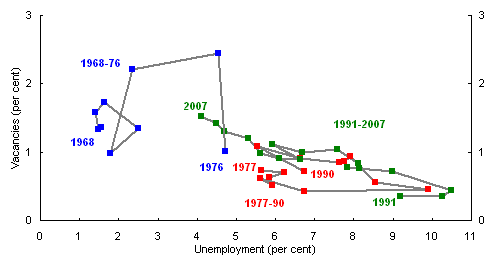 Advanced Macroeconomics
Advanced Macroeconomics
Tuesday and Thursday 12:45 - 14:15 in I-063
Lecture number: 173220
Main text: David Romer, 2012, Advanced Macroeconomics, 4e, McGraw-Hill
Course material for participants is available at the course material webpage.
Course Plan
Theme 1: Growth
1. Introduction - The Solow Growth Model
Reference: Romer Chapter 1
2. Solow Growth Model: Extensions: Education and Capital Mobility
References: Mankiw, N.G., D. Romer, and D.N. Weil, 1992, A contribution to the
empirics of economic growth, Quarterly Journal of Economics 107, 407-437.
Lucas, R.E., 1990, Why Doesn`t Capital Flow from Rich to Poor
Countries?, American Economic Review 80, 92-96.
3. The Ramsey Growth Model
Reference: Romer Chapter 2A.
4. Overlapping Generations: The Diamond Growth Model
Reference: Romer Chapter 2B.
5. Endogenous Technical Progress: The Romer Growth Model
Reference: Paul Romer, 1990, Endogenous Technological Change, Journal of Political Economy 98, S71-S102
6. The Scale Effect, the Jones Model, and Growth in the Very Long Run
References: Michael Kremer, 1993, Population Growth and Technological Change: One Million B.C. to 1990, Quarterly Journal of Economics 108, 681-716.
Romer 126-131.
7. Unified Growth Theory
Reference: Holger Strulik and Jacob Weisdorf, 2008, Population, Food, and Knowledge: A Simple Unified Growth Theory, Journal of Economic Growth 13, 169-194.
Theme 2: Real Business Cycles
8. Stylized Facts about Business Cycles and the Simplest RBC model
Reference: Romer Chapter 4.1-4.5.
9. The General Real Business Cycle Model
Reference: Romer Chapter 4.6-4.10.
Theme 3: New Keynesian Economics
10. Price and Wage Rigidity
Reference: Romer Chapter 6.1-6.4.
11. Monopolistic Competition and Menu Costs
Reference: Romer Chapter 6.5.-6.8.
12. The Lucas Imperfect Information Model
Reference: Romer Chapter 6.9.
13. DSGE Models of Fluctuations
Reference: Romer Chapter 7.1.-7.2.,7.4., 7.8.-7.9
Theme 4: Unemployment
14. Efficieny Wages
Reference: Romer Chapter 9.1-9.3.
15. The Shapiro-Stiglitz Model
Reference: Romer Chapter 9.4.
16. Search and Matching
Reference: Romer Chapter 9.8-9.9.
17. Trade Unions and Unemployment
References: McDonald, I.M. and R.M. Solow, 1981, Wage bargaining and employment, American Economic Review 71, 896-908;
Nickel and Andrews, 1983, Union, real wage, and employment in Britain 1951-79, Oxford Economic Papers 35, 183-206;
Lindbeck, A. and D. Snower, 1988, Cooperation, harassment and involuntary unemployment: an insider-outsider approach, American Economic Review 78, 167-188.
Theme 5: Consumption
18. The Permanent Income Hypothesis
Reference: Romer Chapter 7.1-7.3.
19. Risk Aversion and Prudence
Reference: Louis Eeckhoudt, Christian Gollier, Harry Schlesinger, 2005, Economic and Financial Decisions under Risk, Princeton University Press, Ch.1.
20. Liquidity Constraints and the Equity Premium Puzzle
Reference: Romer Chapter 7.1-7.3.